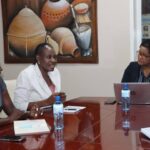Botswana celebrates 49 years of independence today, as it was colonized in 1966 by the British Protectorate. Today is a public holiday and many Batswana are celebrating the day in various events scheduled across the country. Take a moment to read 10 interesting facts about your country since independence.
- Formerly Bechuanaland Protectorate under the British, Botswana became independent in 1966. Bot swana means “place of Tswana” in the dominant national language ( Set swana), and the citizenry are called Bat swana, or Tswana people.
- Botswana is a landlocked and arid country. Bordering on South Africa, Zimbabwe, Namibia, and Zambia, it is 224,607 square miles (581,730 square kilometers) in area, about the same size as France.
- Two-thirds of the country is comprised of the Kalahari Desert, which is covered with grasses and scrub but has scarce surface water. Mean annual rainfall ranges from under 10 inches (250 millimeters) per annum in the southwest to over 25 inches (635 millimeters) in the northeast
- Botswana’s population has grown from 600,000 people in 1971 to an estimated 1,600,000 in 2000. While very high growth rates in the 1970s and 1980s have declined, high birth rates and declining infant mortality have led to a population structure heavily skewed toward young people: 43 percent of the population was under fifteen in 1991. Now the popolation is a little over 2million.
- Bantu, Khoisan, and Indo-European languages are spoken in Botswana. English and Setswana are the official languages. This means that the language of government and higher education is primarily English, but that Setswana is the dominant language spoken in the country.
- “Pula,” the Setswana word for rain, is featured on the coat of arms, and is called out frequently at public gatherings as a salute and cry of approbation. It is also the term for the national currency.
- The national anthem is “Lefatshe la Rona,” (“Our Country”), and its title captures the strong attachment most Batswana feel to the land and its resources, as well as some anti-foreign sentiments. It was composed by the late K.T. Motsete.
- Cattle were tremendously important not just to a material economy but also to the symbolic economy of status, family, and social relations in the past, and cattle remain powerfully evocative to most Batswana today.
- Diamonds were discovered soon after independence was granted, and the prudent and equitable use of their revenues has underwritten stability and the repeated reelection of the dominant political party.
- Sorghum or corn meal porridge is the staple of most Botswana meals. People wake in the morning to a thinner version of the porridge, sometimes enriched with soured milk and/or sugar, and tea. A thicker version of the porridge, known as bogobe , anchors the substantial midday meal, accompanied by a stew of meat and/or cabbage, spinach (or wild greens), or beans. Read more: http://www.everyculture.com/Bo-Co/Botswana.html#ixzz3nCrc3oTK










